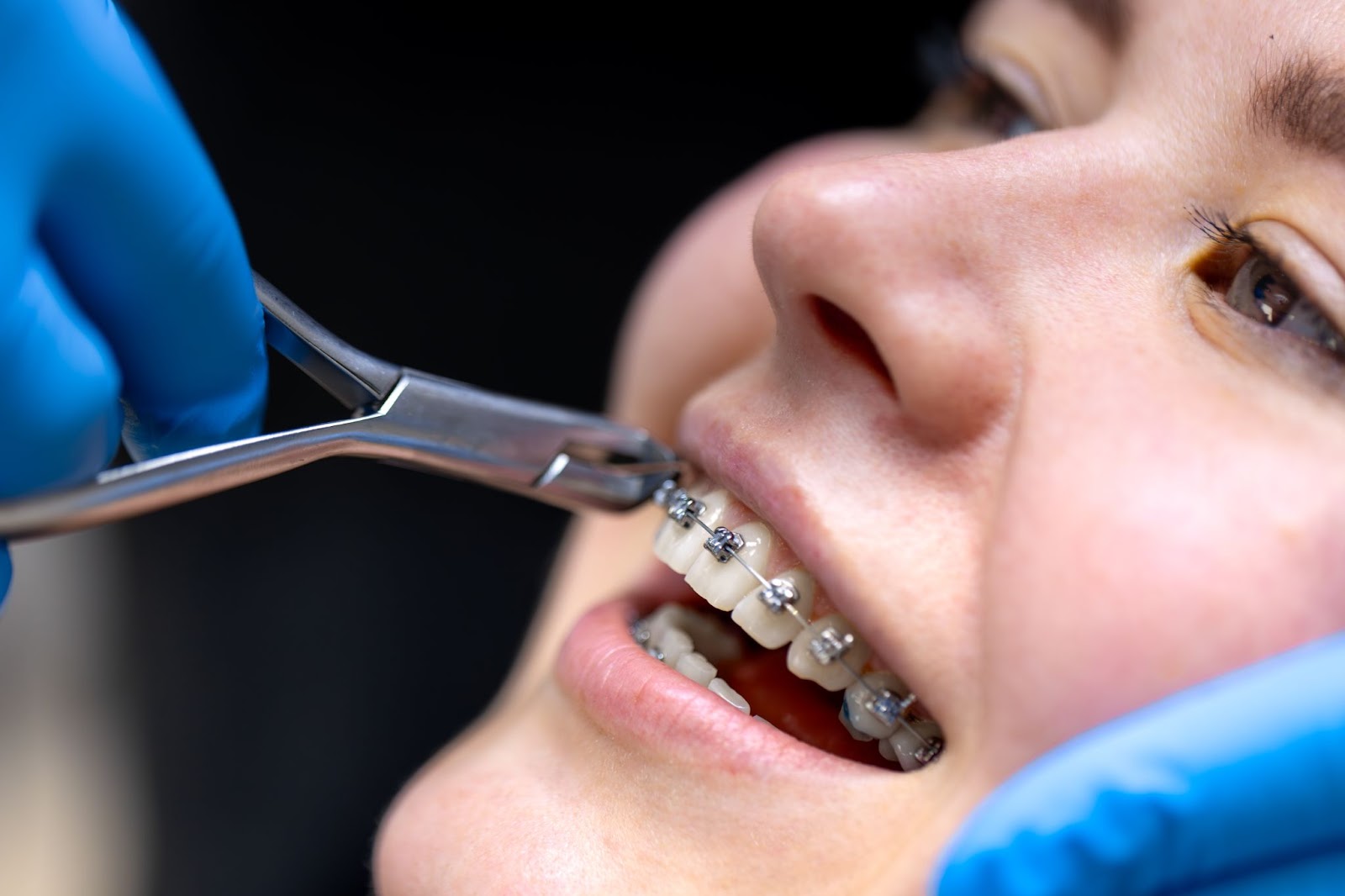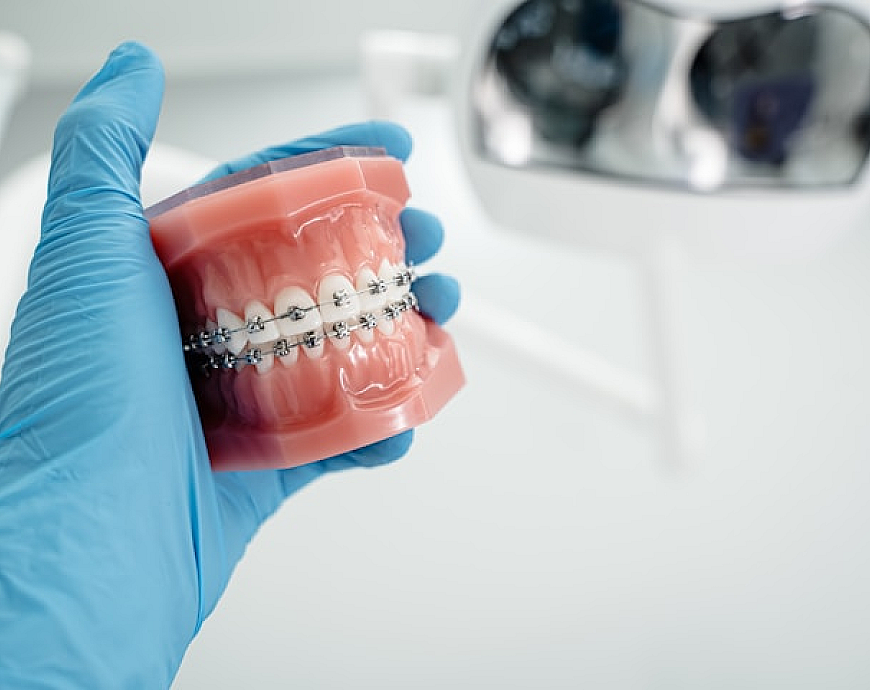Metal braces are the reference standard in fixed orthodontic treatments, due to their predictable biomechanical behavior, increased resistance to masticatory stresses and high efficiency. Orthodontic treatment with metal braces aims to achieve a functional, stable and aesthetic occlusion by applying controlled orthodontic forces to the teeth. Orthodontic therapy is applied in multiple clinical contexts, from dental crowding or abnormal spacing to malocclusions or dental eruption anomalies.
What is a metal brace?
A metal brace is a fixed orthodontic device that is applied directly to the teeth in order to correct their alignment and improve the functionality of the occlusion. A metal brace uses controlled forces, transmitted through springs and auxiliary components, to generate programmed dental movements. The elements of the metal braces are mounted on each tooth individually and act as a whole to modify the position of the teeth on the arches. The orthodontic system is considered standard in orthodontics due to its biomechanical efficiency and favorable cost-effectiveness.
Metal dental braces - Components
Metal dental brace is made up of several interconnected components, each with a precise role in transmitting and controlling orthodontic forces. The components are:
- brackets (individual metal elements fixed on the vestibular surface of each tooth);
- elastics (rings used to apply forces between different segments of the braces);
- ligatures (serve to fix the orthodontic wire in the bracket slot);
- orthodontic arches (the main active element);
- bands (metal rings applied to the posterior molars, on which tubes are cemented to guide the arches or to attach auxiliary devices);
- metal rings for molars (in some cases, rings are used as an alternative to traditional bands).
Metal Braces - Advantages and Disadvantages
The structure of the braces allows for the transmission of controllable orthodontic forces, with applicability in the correction of a wide range of dental and skeletal malocclusions. Like other orthodontic treatments and devices, metal braces have both advantages and disadvantages.
Metal Braces - Advantages
Metal braces have the lowest price of all types of braces, with low cost being its main advantage. In addition, other major advantages include:
- superior mechanical strength compared to other types of braces (metal braces do not fracture easily under conditions of intense mechanical stress);
- increased efficiency in most dental anomalies;
- brackets can be re-aligned without compromising the treatment plan;
- small dimensions of the components;
- rapid and atraumatic removal from the enamel.
Metal braces - Disadvantages
Despite their robust functional character, metal components involve certain aesthetic compromises, and tolerance to discomfort varies between individuals. The main disadvantages of using a fixed metal orthodontic brace:
- it is more visible than ceramic or sapphire braces;
- aesthetic limitations compared to other types of braces;
- may cause greater discomfort than other braces.
Metal braces - When are they recommended?
Metal braces are indicated in the treatment of a wide range of dental and occlusal anomalies, regardless of the patient's age. The treatment recommendation is made following a clinical and radiological evaluation, which aims to identify the type and severity of the malocclusion, as well as the analysis of bone structure and muscle function. Among the dental problems that require orthodontic treatment with metal braces are:
- dental crowding;
- the presence of abnormal distances between the teeth;
- deep bite;
- open bite;
- reverse bite (anterior or posterior crossbite);
- dental protrusions;
- class II and III malocclusions;
- ectopic tooth eruption;
- impacted canines.

Metal braces - Orthodontic treatment stages
Orthodontic treatment with metal braces involves a clear sequence of stages that pursue specific objectives. In just a few weeks from the time of the consultation, the patient can benefit from the treatment.
✅Initial consultation
The stage consists of the clinical evaluation of the patient, in order to identify the type of malocclusion, the severity of dental imbalances and the possible need for additional treatments. The orthodontist examines the dental alignment, the relationship between the jaws, the presence of facial symmetry and possible bad habits (mouth breathing, infantile swallowing). If the patient is eligible, it is recommended to create an orthodontic file to establish a therapeutic plan.
✅Creating an orthodontic file
The orthodontic file includes all the clinical, radiological and photographic data necessary to establish a precise treatment plan. Standardized intraoral and extraoral photographs, digital or classic impressions are taken to obtain study models, a panoramic radiograph and lateral profile teleradiography. The doctor formulates a complete orthodontic diagnosis, followed by the treatment plan, which includes clear objectives, estimated duration, type of braces required and possible extractions.
✅Treatment of possible dental problems
Before applying the braces, the doctor must ensure that the dental and periodontal status is stable. All active caries must be treated, and teeth with deep lesions require endodontic treatments. If there is tartar or gingival inflammation, professional scaling is performed and rigorous hygiene at home is indicated.
✅Fitting the braces
The fitting of the metal dental braces is done in a single session, under strict control of asepsis and isolation. It begins with complete hygiene of the teeth, followed by conditioning the enamel with orthophosphoric acid. Special adhesive is applied, then the brackets are positioned on each tooth, according to a pre-established clinical and anatomical guide. After light-curing, the orthodontic arch is inserted into the bracket slot, and fixation is achieved with elastomeric or metal ligatures. The fitting takes between 60 and 90 minutes and marks the actual start of active orthodontic treatment.
✅Periodic adjustments
Periodic adjustments are performed at regular intervals, usually every 4–8 weeks, depending on the biological response and the complexity of the case. Depending on the phase of treatment, it is possible to switch from flexible nickel-titanium arches to rigid steel arches, for better control of alignment and space closure. Correctly performed adjustments ensure the progress of the treatment and reduce the risk of relapse or biomechanical complications.

How to maintain metal braces?
Due to the complex structure of the braces, with multiple retentive surfaces, the risk of plaque accumulation and the appearance of carious lesions is significantly increased in the absence of proper hygiene. To prevent complications, proper maintenance of the braces and, implicitly, of the teeth is required. Tooth brushing is performed at least twice a day, using an orthodontic toothbrush, with "V"-shaped bristles, adapted to effectively clean around the brackets and the orthodontic arch. In addition, super-floss, interdental brushes and oral irrigators are used for effective cleaning of dental structures.
Metal braces vs. Sapphire braces - What is the difference between them?
Metal braces and sapphire braces present significant differences in terms of aesthetics, material composition and biomechanical behavior. The metal version uses brackets made of stainless steel or titanium alloys, with high mechanical strength, low profile and affordable costs. In contrast, the sapphire device is equipped with sapphire brackets, completely transparent, which camouflage in the natural color of the teeth. Sapphire brackets are more fragile than metal ones and can give way more easily under conditions of excessive forces.
Metal braces vs. Ceramic braces - What is the difference between them?
Ceramic braces use polycrystalline aluminum oxide brackets, in a shade close to tooth enamel, which gives them a more pleasant appearance, compared to metal brackets. In addition, ceramic brackets reflect less light and are less visible during speech. However, ceramic brackets have increased fragility and a higher coefficient of friction between the slot and the orthodontic arch. In comparison, metal braces are more mechanically resistant, allow for greater force application and withstand more frequent adjustments, without the risk of fracture of the brackets.
How much do metal braces cost?
Metal braces are considered the most affordable option among fixed orthodontic braces, which makes them suitable for a wide range of patients. The cost of metal braces varies depending on the complexity of the case, the type of brackets used and the clinic's pricing policy. The complete list of updated prices of our clinic can be found on the dental services page.
Metal braces - Price
| Procedure | Costs (expressed in RON) |
| Orthodontic consultation + Orthodontic treatment plan | 200 |
| METALLIC braces / arch | 2800 |
| CERAMIC dental braces / arch | 3300 |
| SAFIR dental braces / arch | 3800 |
| Fixed braces control per arch | 100 |
| Replacement of detached bracket (METALLIC braces) | 150 |
| Fixed braces removal per arch | 200 |
How long should metal braces be worn?
The duration of orthodontic treatment with metal braces depends on the severity of the malocclusion, the individual biological response, the patient's age and the regularity of periodic check-ups. On average, orthodontic treatments last between 18 and 30 months, but some cases may require shorter or longer periods depending on the complexity.
In the case of children and adolescents, treatment can progress more quickly due to the increased plasticity of the tissues. In adults, the alveolar bone responds more slowly, but the results are comparable, provided that the forces are applied correctly and the clinical stages are respected. After the device is removed, the retention phase follows, which lasts at least 12 months and aims to maintain the teeth in the position obtained.
Metal braces in children - From what age can they be worn?
The application of metal braces in children is possible after the complete eruption of permanent teeth, usually around the age of 11–13. However, orthodontic evaluation is recommended as early as 6–7 years of age, when early signs of dento-maxillary anomalies can be identified.
Photo sources: Unsplash, Freepik
Bibliography:
https://www.bupa.co.uk/dental/dental-care/treatments/orthodontics/types-of-braces/fixed-braces/traditional-metal-braces
https://www.colgate.com/en-us/oral-health
https://aaoinfo.org/treatments/braces/
https://www.dentalassociates.com/our-services/braces-orthodontics/traditional-braces-phase-2
https://my.clevelandclinic.org/health/treatments/24601-teeth-braces
https://www.progressivebraces.com/will-braces-affect-how-i-sound-when-talking/
https://orthodonticassoc.com/braces-invisalign/guide-cleaning-teeth-braces/
https://www.thedentalsurgery.co.uk/what-to-eat-and-avoid-with-braces/
https://www.dentalassociates.com/dental-topics/foods-avoid-braces
https://www.ollieanddarsh.co.uk/blog/which-is-better-metal-braces-or-ceramic-braces/
https://www.pro-dent.us/blog/metal-braces-vs-sapphire-braces
https://smile2impress.com/uk/blog/sapphire-braces
Frequently asked questions about metal braces

Dr. Laura Roșca answers questions:
+40787877799
contact@dentarbre.comZona Obor - Colentina - Doamna Ghica, București, Romania
